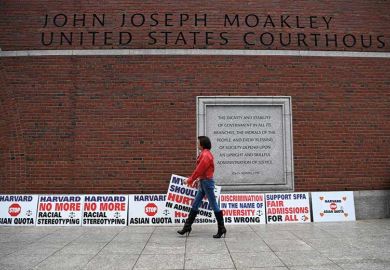Admissions advantages for students from disadvantaged schools fall well far short of what minorities need to achieve more equal representation in higher education, an analysis of a landmark initiative has concluded.
The programme, created more than 20 years ago, gives all students who graduate among the top 10 per cent of their high school a guaranteed slot at any public college in Texas.
The “Texas 10 Per Cent Rule”, subsequently adapted by Florida and California, has been embraced as a way to boost racial diversity in colleges without the legal and political complications of weaving race-based affirmative action preferences into admissions processes.
The analysis by policy researchers at Texas A&M University and the University of North Carolina at Chapel Hill attempts to explain past studies that have suggested that such programmes often do not meaningfully widen participation in flagship public institutions.
The researchers tracked student progress to conclude that the top state universities in Texas have been increasing their racial and socio-economic diversity only in cases where the students are actively recruited and offered extra financial assistance.
The findings demonstrate the cost and complexity of making progress on equity beyond admissions policies, said the authors, Kalena Cortes, an associate professor of public service and administration at Texas A&M, and Daniel Klasik, an assistant professor of education policy at UNC.
“Top X per cent policies can only go so far in addressing these challenges,” Dr Cortes and Dr Klasik said of their findings, which have been distributed by the National Bureau of Economic Research ahead of peer-reviewed publication.
Texas created its Top 10 Per Cent Rule in 1997 after a federal court rejected the constitutionality of its system for granting racial preferences in admissions.
Past studies of that programme and similar versions in Florida and California have shown some benefits, such as expanding the typical admissions pool at top public colleges beyond the more elite high schools that supply the bulk of students.
But Dr Cortes and Dr Klasik, reviewing 18 years of data, said the Texas top 10 Per Cent Plan expanded the number of high schools sending students to top state universities without making a significant difference to the overall racial and socio-economic imbalances.
The more limited instances where high schools did send more minority students were most clearly associated with schools participating in two other state programmes that offered targeted recruiting and scholarships, the researchers said.
“The Top 10 Per Cent Plan does not seem like a solution for creating meaningful racial diversity,” Dr Cortes and Dr Klasik said. “But it is better than nothing.”
Register to continue
Why register?
- Registration is free and only takes a moment
- Once registered, you can read 3 articles a month
- Sign up for our newsletter
Subscribe
Or subscribe for unlimited access to:
- Unlimited access to news, views, insights & reviews
- Digital editions
- Digital access to THE’s university and college rankings analysis
Already registered or a current subscriber?








